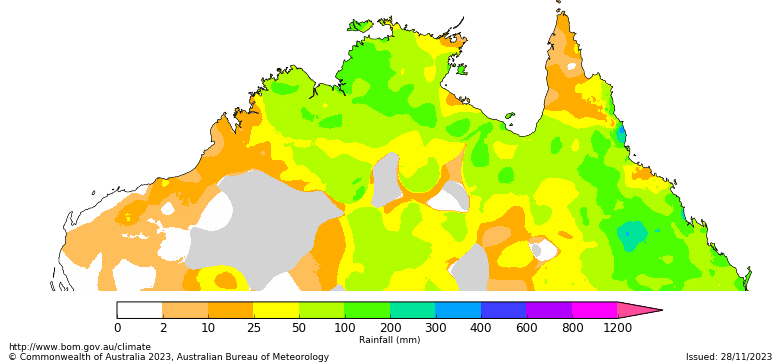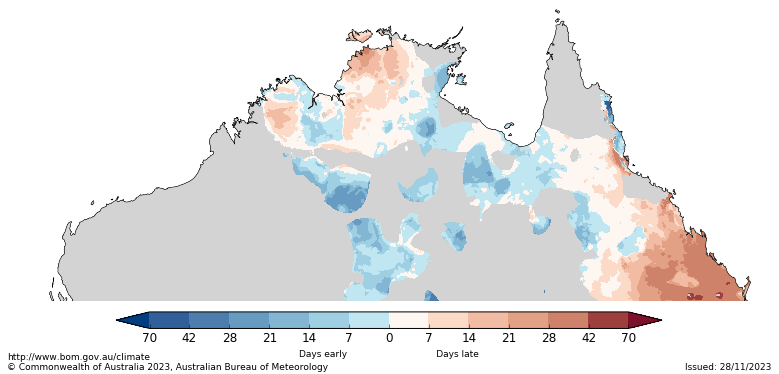Key issues
- For the week ending 29 November 2023, widespread showers and thunderstorms resulted in flash flooding and significant damage in eastern parts of the country.
- These falls will likely provide sufficient soil moisture to allow for the widespread sowing of dryland summer crops in Queensland and northern New South Wales.
- Significant rainfall in South Australia, Victoria and southern New South Wales could delay harvest and led to grain quality downgrade of unharvested winter crops.
- The widespread rainfall across much of eastern and northern Australia is expected to provide a significant boost to soil moisture levels and pasture growth rates and availability.
- Northern Australia rainfall onset with at least 50 millimetres has occurred over large areas with eastern Queensland and parts of northern Australia recording later than usual onset.
- These falls are important to stimulate pasture growth for livestock feed.
- Over the coming week, lows will generate storms and showers in eastern and central Australia and across the tropical north.
- Further rainfall in Queensland and northern New South Wales cropping regions will boost sub-soil moisture to support growth of summer crops and pasture.
- Dry conditions in Western Australia should allow for the remaining harvest to continue without delay.
- Water storage levels in the Murray-Darling Basin (MDB) decreased between 23 November 2023 and 30 November 2023 by 29 gigalitres (GL). Current volume of water held in storage is 15 853 GL. This is 8 percent or 1390 GL less than at the same time last year.
- Allocation prices in the Victorian Murray below the Barmah Choke decreased from $121 on 23 November 2023 to $99 on 30 November 2023. Prices are lower in the Goulburn-Broken due to the binding of the Goulburn intervalley trade limit.
Climate
For the week ending 29 November 2023, widespread showers and thunderstorms impacted much of northern and eastern Australia. A major storm system developed over south-east Australia generated flash flooding in many areas and significant damage from violent, rotating supercell thunderstorms. Large areas of northern, eastern Australia, Tasmania, and including southeast South Australia received rainfall between 25 to 100 millimetres. Isolated areas in New South Wales, Queensland and Northern Territory recorded rainfall in excess of 100 millimetres. In contrast, large areas in Western Australia, South Australia and southern Northern Territory remained dry this week.
Across eastern cropping regions, rainfall totals of up to 100 millimetres were recorded, with localised areas in New South Wales and Queensland recording in excess of 100 millimetres. These falls will have boosted sub-soil moisture to support summer crops such as sorghum. However, rainfall in South Australia, Victoria and New South Wales would have delayed harvest of remaining winter crops and will likely affect grain quality.
The widespread falls of between 25 and 200 millimetres are expected to provide a significant boost to soil moisture levels, and pasture growth rates and availability across much of eastern and northern Australia. This will likely result in a reduced reliance on supplementary fodder to maintain the production of livestock and livestock products.
Rainfall for the week ending 29 November 2023
Issued: 29/11/2023
Note: The rainfall analyses and associated maps utilise data contained in the Bureau of Meteorology climate database, the Australian Data Archive for Meteorology (ADAM). The analyses are initially produced automatically from real-time data with limited quality control. They are intended to provide a general overview of rainfall across Australia as quickly as possible after the observations are received. For further information go to http://www.bom.gov.au/climate/rainfall/
Intense rainfall on 28 and 29 November has led to flash flooding across large areas of southern Queensland, and the issuing of flood warning across the far southeast of New South Wales and much of eastern Victoria.
Flooding is forecast to continue across many catchments over New South Wales and Queensland, and emerge across Victoria in the coming days, as flood peaks move downstream and with heavy rainfall forecast for much of Australia’s south-eastern seaboard during the next 8 days.
It is too early to say what the full impact this flooding across New South Wales, Queensland and Victoria will be on agricultural producers and communities. As the event is still ongoing many farmers will still be surveying the damage, with limited ability to undertake detailed assessments at this stage. There will be significant localised impacts. However, the damage is unlikely to significantly affect the value of and quantity of national agricultural production.
Flooding, as considered here, is generally a localised event and tends to follow river valleys, spreading across the flood plain and lower lying areas to varying extents. As a proportion of total land, the actual area of land affected is usually relatively small.
Flood watch and warning areas on 30 November 2023
The timing of Northern Australia rainfall onset is important indicator for seasonal pasture growth and potential livestock production. The rainfall onset gives an indication of the accumulation of at least 50 millimetres of rainfall after 1 September to stimulate plant growth after the northern dry season.
Between 1 September and 28 November 2023, large areas of northern Australia have received at least 50 millimetres of rainfall. Northern parts of Western Australia, Northern Territory and across large areas of eastern Queensland have recorded onset later than usual. Rainfall in northern Australia for this time of the year is important for pasture and feed availability.
Northern rainfall totals: 1 September to 28 November 2023
Number of days earlier or later than the long-term average onset date
Over the 8 days to 7 December 2023, lows and troughs are expected to generate rainfall and storms in eastern Victoria, south-eastern New South Wales, eastern and northern Queensland, and the northern tropics of the Northern Territory and Western Australia. A high-pressure system is expected to bring mainly dry conditions to much of Western Australia, South Australia and western New South Wales.
Across cropping regions, rainfall totals between 5 and 25 millimetres are forecast for Queensland. If realised, these falls will provide an ideal follow-up to rainfall already recorded during November and provide a timely boost to soil moisture and stimulate some useful early summer pasture production. These falls will also provide grain growers with added confidence to plant dryland summer crops such as sorghum across northern Queensland.
The dry expected conditions will allow recently saturated soils to dry out in New South Wales and Victoria and allow for the continuation of for harvest activities in the coming weeks. Little to no rainfall across Western Australia and South Australia will allow for the uninterrupted harvest of remaining winter crops.
Total forecast rainfall for the period 30 November 2023 to 7 December 2023
Issued 29/11/2023
Note: This rainfall forecast is produced from computer models. As the model outputs are not altered by weather forecasters, it is important to check local forecasts and warnings issued by the Bureau of Meteorology.
Water
Water storages, water markets and water allocations - current week
The Tableau dashboard may not meet accessibility requirements. For information about the contents of these dashboards contact ABARES.
Commodities
Information on weekly price changes in agricultural commodities is now available at the Weekly commodity price update.





